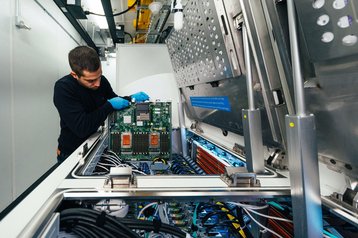I don't have any influence over the syllabus at DCD>Academy, but I'd be willing to place a small bet that sometime next year or the year after, our sister division will invite you to a course in data center plumbing.
We have long heard that air cooling can no longer meet all the cooling demands of today and tomorrow. But now the evidence is there.
Doing the math
Anyone in any doubt should check a joint presentation from this week's DCD>Connect by Jon Summers and Tor Björn Minde of RISE. It's a half-hour physics workout that demonstrates that the thermal resistance of air cooling is too high to cool the GPU systems needed for AI systems like GPT-4.
Along the way we also find that AI training and inference usage will roughly balance - inference used less power but has many more users - and the total power demand of AI will match the entire output of countries like Sweden. We will have to return to those thoughts in the future.
But on the subject of liquid cooling, we saw another illustration of its changing attitudes this week.
When AQ Compute's Oslo facility was delayed, the company switched its focus from colocation to HPC and AI - and realized this massively increased the cooling demands.
AQ installed a water circulation system under the raised floor and put heat exchangers on all the cabinet rear doors.
These will remove the majority of the heat. The remainder can be handled by Norway's cool air, leaving AQ free to dispose of HVAC systems which are now surplus to requirements.
That's still going to be an unusual step. As I said last week, most data centers will still have some kind of air cooling, even when liquid cooling rewrites the rules inside the white space.
But AQ also faced a new demand. The extra pipework will need installation and maintenance.
So the company is expecting to hire significant numbers of plumbers, and is working with local schools on training and apprenticeships for those bringing liquids into the data center.
Training
Do we really need specialized plumbers? After all, water and other fluids had already been channeled for thousands of years, when the Romans professionalized the field, and gave it the name we still use today, based on plumbum or lead.
We now use many other materials for pipes and tubing, from copper to PVC, and there are a vast range of joints and techniques that keep our kitchens and bathrooms dry and functional.
But working in white space will be a step up. The pipes will be running hard by high-voltage electric circuits, and deliver cooling to sensitive electronics.
They will have to be safe in normal operation, and operate unattended in inaccessible spaces.
They must also be future-proofed. AQ is planning to plumb direct-to-chip cooling loops into its circuit when heat densities require them. And data centers will bring on an array of primary circuits and tanks using other fluids beyond water.
It will take considerable expertise to ensure that different fluids can flow at the right speed past electronics and heat exchangers, to transfer heat effectively.
At DCD>Connect, we also met Gemma Reeves of Alfa Laval, a company with more than a hundred years of experience in industrial processes.
She told us that the dielectric coolants on offer have a wide range of thermal and physical properties, which will make a huge difference to how one chooses and use them.
Liquid cooling vendors have been waiting for this day for a long while. Now it's up to the rest of us to step up and learn enough to meet the challenge.





